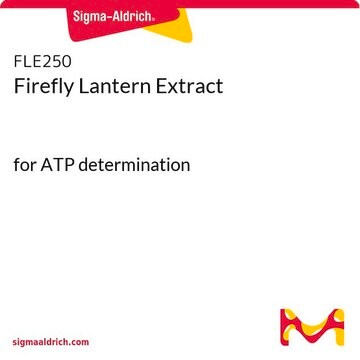L8507
Luciferase from Vibrio fischeri (Photobacterium f)
lyophilized powder
Synonym(s):
Bacterial Luciferase, Luciferase from Photobacterium fischeri
Sign Into View Organizational & Contract Pricing
All Photos(3)
About This Item
Recommended Products
Looking for similar products? Visit Product Comparison Guide
Related Categories
Application
Luciferase from Vibrio fischeri has been used in a study to assess kinetics of light emission and oxygen consumption by bioluminescent bacteria. It has also been used in a study to investigate the sensitivity of dark mutants of various strains of luminescent bacteria to reactive oxygen species.
Features and Benefits
Partially purified, soluble extracts containing FMN-dependent luciferase and NADH- and NADPH-dependent FMN reductases. Produces light in a system containing FMN, NADH or NADPH, and n-decyl aldehyde.
Other Notes
ATCC No. 7744 balance primarily buffer salts and stabilizer.
Physical form
Partially purified lyophilized powder
Signal Word
Danger
Hazard Statements
Precautionary Statements
Hazard Classifications
Resp. Sens. 1
Storage Class Code
11 - Combustible Solids
WGK
WGK 1
Flash Point(F)
Not applicable
Flash Point(C)
Not applicable
Personal Protective Equipment
dust mask type N95 (US), Eyeshields, Gloves
Certificates of Analysis (COA)
Search for Certificates of Analysis (COA) by entering the products Lot/Batch Number. Lot and Batch Numbers can be found on a product’s label following the words ‘Lot’ or ‘Batch’.
Already Own This Product?
Find documentation for the products that you have recently purchased in the Document Library.
Customers Also Viewed
Loredana Peca et al.
FEMS microbiology letters, 289(2), 258-264 (2008-11-20)
Two whole-cell bioluminescent reporters were constructed by fusing the reporter genes luxAB with the Co(2+) and Zn(2+) inducible coaT promoter or the Ni(2+)-inducible nrsBACD promoter, respectively, in the genome of Synechocystis sp. PCC 6803. The obtained reporters, designated coaLux and
Prashant K Sharma et al.
Surgery, 147(1), 89-97 (2009-09-08)
Bacterial peritonitis is a life-threatening abdominal infection associated with high morbidity and mortality. The rat is a popular animal model for studying peritonitis and its treatment, but longitudinal monitoring of the progression of peritonitis in live animals has been impossible
Xin-Xin Huang et al.
Huan jing ke xue= Huanjing kexue, 29(11), 3159-3165 (2009-02-04)
Recombinate luminescence bacteria have the important role in evaluating water toxicity. Two recombinate luminescence bacteria vectors PUCD-uvrA and PUCD-alkA were constructed to investigate the impaired mechanism of pollutant genetic toxicity. The genes of uvrA and alkA were amplified by PCR
Thomas E Crowley
Biochemistry and molecular biology education : a bimonthly publication of the International Union of Biochemistry and Molecular Biology, 39(2), 126-132 (2011-03-30)
The genes responsible for luminescence in various species of the marine microorganism Photobacterium, have been used for many years as a tool by researchers and instructors. In particular, the lux operon of Photobacterium fischeri has been used by many instructors
Patricia G Cruz et al.
Chemistry & biology, 18(11), 1442-1452 (2011-11-29)
The chemical diversity of nature has tremendous potential for the discovery of molecular probes and medicinal agents. However, sensitivity of HTS assays to interfering components of crude extracts derived from plants, and macro- and microorganisms has curtailed their use in
Our team of scientists has experience in all areas of research including Life Science, Material Science, Chemical Synthesis, Chromatography, Analytical and many others.
Contact Technical Service








